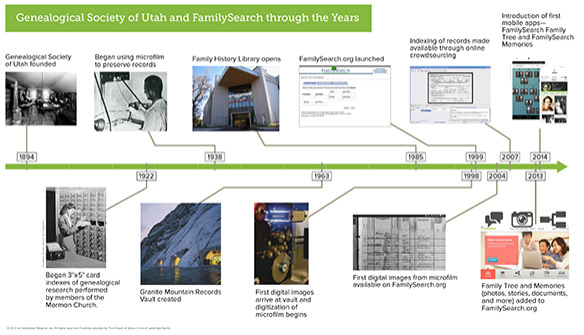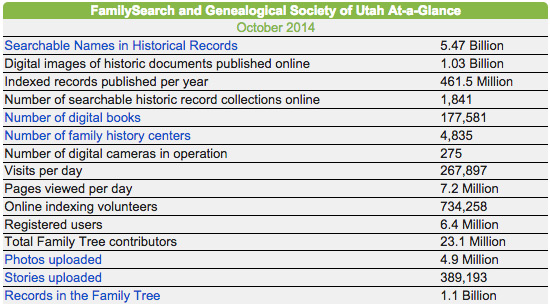The following News Release is from FamilySearch:
Salt Lake City, Utah November 13, 2014 -“Whatever your past perceptions, it is different now!” proclaimed Allan F. Packer, in a recent worldwide broadcast, describing the ever growing popularity of online ancestry research and the broad range of inviting online family history activities. Packer is the Executive Director of FamilySearch International (FamilySearch.org ), formerly the Genealogical Society of Utah. 120 years ago today, the obscure nonprofit organization held its first meeting under the direction of its first president, Franklin D. Richards. Billions of historic records and millions of subscribers later, it has become a premier global leader in the online genealogy space helping more people than ever discover their ancestors.
What started as a charge to begin gathering its first published family histories and historical records from around the world to help its members (predominantly Mormon immigrants at the time) with their genealogical research, today, has morphed into the free public family history mega-site, FamilySearch.org. It entertains millions of patrons a month seeking to find, connect, preserve, or share their ancestral roots and memories, and publishes hundreds of millions of new historic records online each year from archives around the world.
David E. Rencher, the organization’s Chief Genealogy Officer said, “People today have such a vast reservoir of resources at FamilySearch.org to draw from, that many historical gems which were previously buried in obscurity are now readily available online. The family links that can be made from these rich resources will blossom into the most complete picture we’ve ever had of the human family.”
FIRST THINGS FIRST
In 1894, the Genealogical Society of Utah was formed under the direction of Wilford Woodruff, then President of The Church of Jesus Christ of Latter-day Saints, to assist members of the faith to seek out their ancestors and preserve their family trees for future generations. Today, the vast collection of historical records and other family history preserving and sharing services are available for free to anyone at FamilySearch.org, in 4,745 family history centers, and the famous Family History Library in Salt Lake City, Utah.THE GREAT DEPRESSION BRINGS UNEXPECTED RESULTS
During the Great Depression in the 1930’s, interest in genealogy increased. Previous to this time, involvement remained low. “Many who were out of work took the opportunity to do some long neglected family research. One Society staff member noted that there was probably more work done in this period than at any previous time, with the library filled to capacity” (Allen, James B., Jessie L. Embry, Kahlile B. Mehr, Hearts Turned To The Fathers, Provo, Utah, 1995, 92).PIONEERS OF LONG-TERM DATA PRESERVATION
In 1938, the society became a veritable pioneer in the broad use of microfilm to preserve and provide broader access to the world’s historic genealogical records—with hundreds of microfilm cameras in operation in dozens of countries. Revolutionary at the time, the special cameras would take a picture of a historic document shrinking the image down to roughly one percent of its original size on the film that could then be magnified using a microfilm reader. In addition, if properly stored, the film could be preserved for at least 500 years!CAVE OF WONDERS
In 1963, the Society completed the Granite Mountain Records Vault in Salt Lake City. This incredibly designed, climate-controlled vault provided the perfect conditions for long-term storage of the microfilmed records and is still used today to protect over 2.4 million rolls of film from over 120 countries and principalities against the effects of time and nature. Today, FamilySearch uses proprietary digital cameras to preserve the world’s records and publish them online more quickly. It operates 285 camera teams daily in 45 countries, and publishes about 100 million new images of historic records each year online—most of which have never seen the light of the Internet. FamilySearch is also digitally converting its massive, historic microfilm collection, making most of it accessible for online viewing 24/7.EVOLVING FAMILY HISTORY TECHNOLOGY
In 1984 the society pioneered one of the first desktop genealogy management software programs on the market (Personal Ancestral File) and is credited with developing GEDCOM (GEnealogy Data COMmunication), a software code that helped launch the genealogy technology industry and enabled users to save and share genealogical data.No longer serving a local customer base, the Genealogical Society of Utah eventually began operating as FamilySearch to align with its expanded international operations and growing, widespread consumer base. It launched its popular free website, FamilySearch.org, in 1999, today is available in 10 languages.
In 2007, to make its growing historic record collections more easily searchable online, FamilySearch pioneered the adaptation of Internet crowdsourcing by creating a web platform where hundreds of thousands of online volunteers can look at digital images of historic records and make the genealogically significant information freely searchable online for people seeking family connections. This ongoing initiative is called “indexing” (See FamilySearch Indexing). Volunteers have made over 1 billion records searchable in this manner in just 7 years, including the popular collections, United States Censuses 1790 to 1940.
In 2013 FamilySearch introduced its free online Family Tree service and Memories feature. These online tools allow users to freely build, preserve, and share their family trees, photos, stories, and historical documents collaboratively. Individuals and families have already contributed over a billion records.
Today, FamilySearch is a premier records preservation brand that is well respected amongst archivists globally and a top consumer website serving tens of millions of individuals and families each year who use it to build, preserve, share, and research their family histories and records. Find out more at FamilySearch.org.

